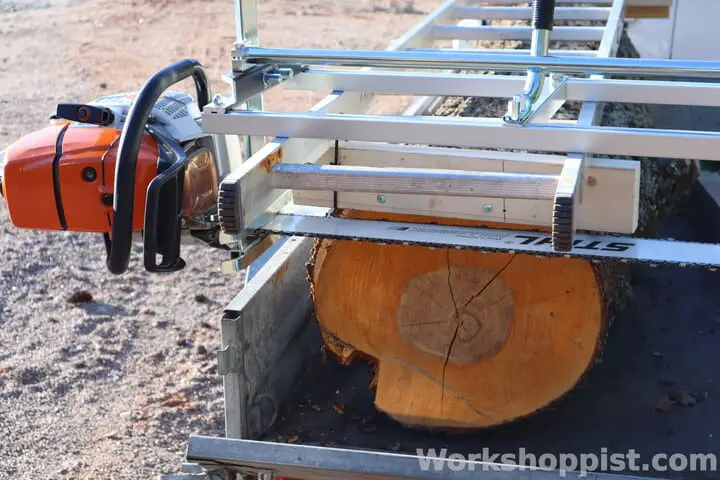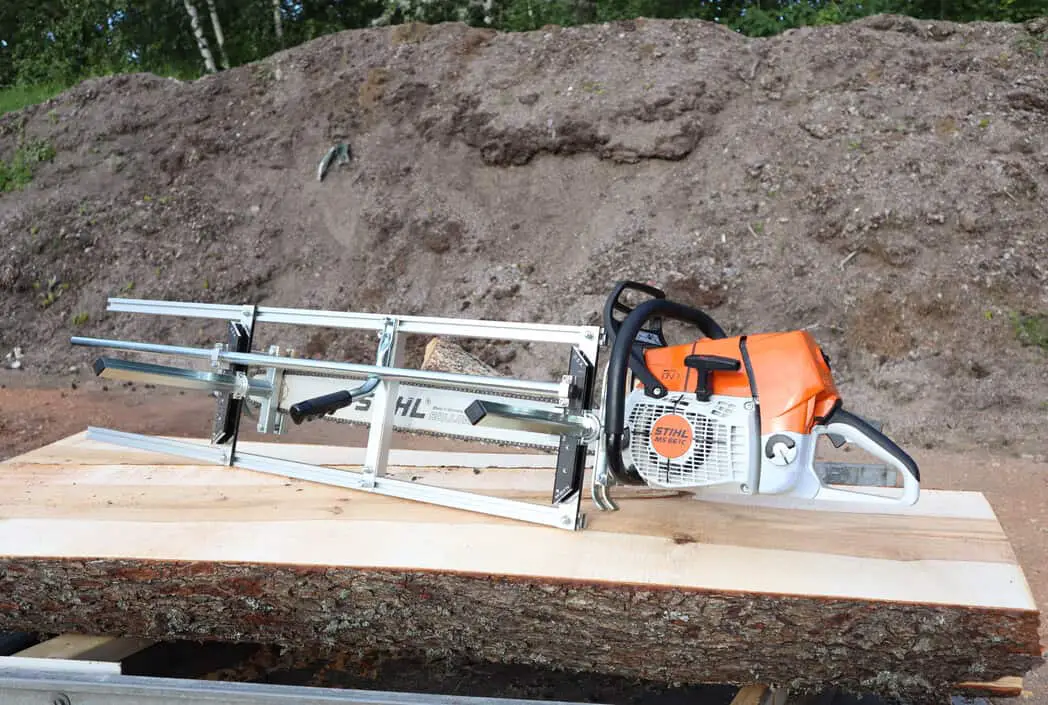Chainsaw milling is growing in popularity. I recently purchased Granberg’s Alaskan Mill, which is one of the most popular milling attachments – you can read my review of the Alaskan Mill MKIV here.
When choosing the mill and getting it up and running, I had quite a few questions for which it was not very easy to find clear answers. How to choose the frame size? Which bar and saw will fit? What else do I need?
I decided to write this article where I gathered the questions I had and answer them in a clear way. I hope this will help you to get started quicker with your Alaskan Mill!
Which Alaskan Mill size should I get?
Pick an Alaskan Mill version at least 4″ longer than the diameter of the thickest log you are planning to mill.
The Granberg Alaskan Mill MKIV comes in 8 different length versions ranging from 24” up to 84”. The maximum cutting width is the mill length minus 4”:
max log diameter = mill length – 4”
For example, if you are going to be milling logs up to 30” in diameter, you would need the 36” mill version.
Note that extra mill length will not hurt you. Having some excess length may in fact make the mill easier to balance. If the frame is too long to fit your car, you can also cut the top rails shorter.
How powerful a chainsaw for Alaskan Mill?
A chainsaw for use with the Alaskan Mill should be as powerful as possible. For best results, use a saw with an engine displacement of 90cc or more.
Granberg officially grades the minimum motor size recommendation with mill length. I have assembled the recommendations to the table below.
I recommend that you stay clearly above the minimum engine size listed. Milling a 20″ log with a 50cc saw is possible but unnecessarily hard.
| ALASKAN MILL LENGTH vs. CC Frame size | Cut width (max.) | Engine size (min.) |
|---|---|---|
| 24” | 20” | 50cc |
| 30” | 26” | 60cc |
| 36” | 32” | 60cc |
| 48” | 44” | 90cc |
| 56” | 52” | 90cc |
| 60” | 54” | 120cc |
| 72” | 68” | 120cc |
| 84” | 70…78” | 120cc |
How long a guide bar for Alaskan Mill?
A guide bar for use with the Alaskan Mill should be at least 6″ longer than the maximum log thickness you are going to mill.
min. bar length = log diameter + 6”
The 6” allowance is needed for the bar clamps at the root and tip of the bar.
Note that bar should also not be much longer than the Alaskan Mill frame: too long a bar will push the powerhead far out from the frame, leading to an unbalanced and dangerous setup.
max. bar length = frame length + 4″
For example, a 36” Alaskan Mill fits saw bars up to 40”, but no longer.
What kind of rail for 1st cut?

Good choices for a 1st cut guide for use with an Alaskan Mill are an aluminum ladder, two pieces of dimensional lumber or Granberg’s own EZ rail system.
An Alaskan Mill needs a guide rail for the 1st cut into a log. Any straight, reasonably stiff material can be used. Practical choices include:
- Simple ladder: relatively narrow straight simple ladders are the best. Check straightness before use. Extension ladders may work (hooks down), but most telescoping ladders, step ladders and platform ladders will not work (no smooth front face).
- Dimensional lumber: Two 1×4’s or 2×4’s nailed together as a tall and narrow box – check straightness before use. LVL studs and beams are particularly good thanks to their straightness and stability.
- Granberg EZ rail system: an adjustable modular aluminum guide system. Extendable, comes in 5-foot sections, smart attachment mechanism.
Can you DIY an Alaskan Mill?
While an Alaskan Mill can be made only by Granberg who owns the trademark, you can make a similar chainsaw mill yourself.
A very basic Alaskan-style mill can be made, for example, from a piece of plywood serving as the top frame and threaded rods as adjustment posts.
Most DIY chainsaw mills will not be able to compete with the Alaskan Mill in ease of use of safety, though.
Do you need a ripping chain w. Alaskan Mill?
A ripping chain is not absolutely necessary for chainsaw milling, but highly recommended. A ripping chain will allow your saw to cut lighter, steadier and more accurate.
You can get ripping chains from many manufacturers – for more info, see my article on ripping chains. Alternatively you can turn your regular (cross-cutting) chain into a ripping chain by following my instructions in a previous article.
Alaskan Mill vs. Bandsaw Mill?
Bandsaw mills are an alternative to chainsaw mills like the Alaskan. How do the two portable mill types compare?
Alaskan Mill is lighter, smaller and more affordable than a bandsaw mill; it has lots of cutting capacity for its size, weight and price. On the other hand, an Alaskan Mill is less energy-efficient, slower, and wastes more wood due to the wide kerf.
Bandsaw mills are faster, more accurate and efficient, all thanks to the narrower kerf of the bandsaw blade. On the other hand, bandsaw mills are also bigger, heavier and more expensive.
For most hobbyists, an Alaskan Mill is the best choice to get started. You can upgrade later on to a bandsaw mill if you are going to be sawing large volumes of dimensional lumber.
